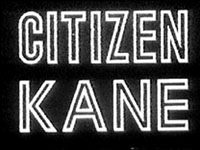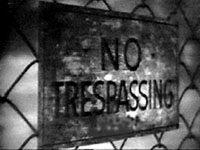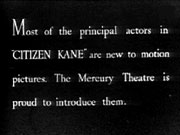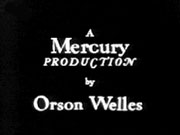  Fig. 1-4 |
  |
As examples of how film title sequences and endings may function, I
will discuss primarily three films by Orson Welles: Citizen Kane,
Touch of Evil, and Othello. In doing this I shall take up not
just titles, but main titles (the name of the film) and
credits and opening texts (different kinds of texts
beginning or introducing the narration, the chain of events or the like). Taken
together these elements may be said to form the exposition of the film.
Finally, I will combine this with endings that (in some cases at least) may be
considered closing answers to the exposed "questions" of the openings.
  Fig. 1-4 |
  |
 Fig. 5  Fig. 6 |
All of these texts are in white on a black screen and with no sound. Only when the screen has faded to black after the main title and before the first shot fades up, the first music is heard, and the action begins. Still, with some possible connection to the name of the film and it's main character, the viewers may assume that the texts are continuing with an opening title in the shape of a sign on a fence: "NO TRESPASSING" (Fig. 6).
Then, through a number of dissolves and tilts we move past fences to a gate with the letter "K" on top of it (Fig. 7-9) and further on to the castle Xanadu and the dying Charles Foster Kane and his mumbling of the last word "Rosebud". The text as an integral part of the storytelling is continued in the films "citation" of the newsreel, "News on the March", which besides voice over uses whole screens with narrating texts (Fig. 10-11).
 |
 | |
| ||
 Fig. 10-11 |
 |
To sum up, the opening identifies the title with a person's name. Through this and the other texts we are guided into the story of Kane's life and fate. These elements and their intertwining of the use of texts and the visual opening of the narrative, with it's graphic qualities, lead us into a story with one and only one center of interest: This great and powerful man and the mysteries of his life. (This may be one of the reasons that Welles can get away with his very complicated construction of the narrative in Kane with it's series of flash backs seen and told from the viewpoints of several "witnesses".)
In the course of the film, we are presented with elements of a picture resembling a jig saw puzzle, but no explicit explanation of the hows and whys of Kane's life. At the end, we are left with some of his wealth in the form of the huge hall of Xanadu, which is more like a gigantic warehouse room filled with furniture, an art collection, etc. And one thing which is noticed by none of the characters in the film, but pointed out by the camera: the sled of his childhood that is thrown into the open fire place. "Throw that junk in".
From the burning sled, the picture fades to black, and the following fade in shows Xanadu with smoke pouring out of the chimneys. Two dissolves, then, bring us out of the film, in the same way that we were led into it. From the smoke, the first dissolve takes us to the fence, where a tilt downwards shows the "NO TRESPASSING" sign once again (Fig. 12-15). The second dissolve brings us from this sign to the top of the gate with the letter "K". On this the closing title is superimposed: "The End" (Fig. 16).
  Fig. 12-15 |
  |
 Fig. 16 |
With a few changes (notably the smoke), both the contents of the shots and the formal characteristics are the same as in the opening of the film. Only, their order is reversed. Kane is both the beginning and the end, but... The formal constructions secure the connection between beginning and end, and at the same time, they function as narrative elements, telling their own part of the story. When the "K" is shown with the end title, you can begin asking questions about men like Kane and their lives and the societies they live in.
Another feature of the end titles deserves some remarks. Citizen Kane has a special kind of end credits (Fig. 17-19). The Mercury actors are introduced as new to the film medium. Together with a shot and a bit of dialogue, they are shown on the screen with their names superimposed (Fig. 17-18). The main characters are followed by a list of the minor ones (Fig. 19), notice that Welles is mentioned at the bottom of this list! Then follows the rest of the end credits, foregrounding of course those responsible for screenplay, direction and photography (Fig. 20-21). All this adds another frame to the film as a whole (just as the above mentioned characteristics of the opening and closing sequences of the narrative), because it makes the connection back to the very first frame with "A Mercury Production", followed by the words "By Orson Welles".
Welles, as always, is a very deliberate storyteller, and this way of entering and leaving the universe of a film is one variation of a strategy he is often uses. Whether it is through stylistic means, verbal comments, or special title practice, the effect is: "This is the beginning of a story" - and "Now we have finished the storytelling". This points to a meta-function of opening and end titles and credits. Admittedly this is often foregrounded to a larger extent in Welles' films than in most others. Nevertheless it is an aspect of the way these things function, which we ought to be aware of, because at the opening of a film they set up some patterns for our experience and understanding of the film story, and at the end they are also part of the structuring of how we leave and reflect on it.
 |
 | |
| ||
 Fig. 17-21 |
 | |
In the case of Citizen Kane, we have seen that Welles manages to do two things at the same time: 1) Opening - and closing - a story and 2) giving both the storyteller and his audience a certain distance to it, which also makes room for reflection.
  Fig. 22-25 |
  |
In another article and another perspective I have analyzed the famous long take that opens Welles' Touch of Evil - the idea being that his way of visual storytelling is much more than just a cinematic tour de force and a case of Welles showing off. It is a very precise way of entering and presenting the fictional space of this film. Together with other scenes this opening positions the viewer in relation to places and events through a very specific camera practice. The camera is not just tracking - it is tracking backwards. This means that surroundings and circumstances are only gradually disclosed to the audience, as appropriate for a crime and mystery story (Fig. 22-25).
The camera takes us into the universe of this film through very definite means. As mentioned, it is done "backwards". And the outcome of what I shall call the rhetoric of this stylistic, enunciative practice is a part of the thematic structure, which in this film noir tells about a more or less blind search in an impenetrable universe. In this way the opening title sequence becomes a "talking" gesture from the narrator. A gesture that shows us or demonstrates special characteristics of the world of this film, and does so precisely through the fact that certain things are not shown to us. We may say that this first scene=shot as a concentrate mimes the maze-like quality of the film as a whole.
In fact, Vargas, the Mexican police detective who is working on a narcotics case, is entering a maze of corruption, smuggling, and fabricated/planted pieces of evidence, and we follow the fight between not only him and the Mexican gangster family, the Grandis, but also between him and the American police detective, Hank Quinlan (the villain played by Welles himself).
 Fig. 26-27 |
 |
Near the end of the picture, Vargas has found out not only that Quinlan has faked evidence on several occasions, but also that he has strangled the head of the Grandi family, trying to make it look like a murder committed by Vargas as a revenge for the kidnapping of his wife. He has also convinced Quinlans police partner, Menzies, that Quinlan is guilty. To get his confession on tape, they plan that Menzies is to talk to Quinlan, asking the right questions while wearing a microphone and a radio transmitter, so that Vargas - posted at some distance from them - can record the conversation (during which it is hinted at that a possible explanation of Quinlan's character and way of doing his job has to do with the fact that his wife was strangled years ago) (Fig. 26-27).
That is, comparing this scene to the opening shot and the "mystery" qualities of the rest of this film noir: Both the characters and the audience are moving through an only partially lit universe, and even the closing scene is told in such a way that the "agent of truth", our justice seeking hero, is not able to see his victim. He has to use the microphone trick, and in this way fool Quinlan into admitting his crimes. (One of the ironies of the "solution" is that the man whom Quinlan framed by planting dynamite in his apartment, actually confessed to the bombing in the first scene of the film).
Quinlan's former lover, Tanya, has told him: "Your future is all used up. Why don't you go home?" Instead, in a final attempt to escape his destiny, during the following discussion he shoots Menzies using Vargas' gun, once again trying to frame another man for his own wrongdoings. But the second he is about to kill Vargas with the same gun, his old friend and colleague, Menzies, who has not yet died from his wound, shoots and kills Quinlan (Fig. 28).
<
 Fig. 28 |
This time it is his turn to move backwards. The shot makes him lose his balance and sends him stumbling backwards into the dirty river. He has been trying to play God, but at the end must suffer the consequences of his own manipulations. Tanya and a policeman are witnesses, and when he tells her about the gangster's confession to having placed the bomb, adding that Quinlan was a great detective after all, Tanya comments: "And a lousy cop." His next question, if that is all she has to say about him, gives her the chance to sound the note not only of these closing moments, but of the entire film: "He was some kind of a man. - What does it matter what you say about people?" (Fig. 29). She has apparently known him before his physical and moral deroute and is aware of his background and the possible explanations in his personal history.
 Fig. 29 |
So, this film does not have an ending that adds neatly up to anything you might call a solution or traditional conclusion. There are no clear one way connections between causes and effects. There are patterns that one may discuss as a basis for possible explanations, but the kind of world that this movie depicts doesn't work through ordinary logic and even less through conventional morality, and therefore it is not possible to pinpoint unambiguous connections between simple causes and matching effects.
Still, if we try to sum up the world of this Welles film in one word, it would be the ultimate description of film noir: disillusion (a kind of realism?). This is what you experience with this non-solution, when you have turned around or away from the opening's "backwards" way of entering the plot and have looked through the "tunnel" of the film. Furthermore, this disillusioned world exactly matches the title that opened it all: Touch of Evil.
 Fig. 30 |
It is important to stress that this is the case on all levels of the film practice. It is not only a question of constructing a screenplay in a way that brings the plot line back to thematic or other elements with reference to the starting point. Nor is it just a question of repeating certain formal structures. Or stating simple conclusions; or showing simple effects, or referring to simple, seemingly explanatory causes. The trick is to have both the aesthetics, the formal structures, and the development of the plot come together as one expression. This may, as in the examples already discussed, make beginning and end seem to be points on the same narrative circle.
Both Citizen Kane and Touch of Evil have this principle built into their structure. In another film by Welles, this is done in yet another way. Othello starts with quite a long sequence before we come anywhere near the main title and opening title. And the credits are not shown until the end. The first series of shots show the burial of Othello and Desdemona, and how the villain Jago is locked into a narrow cage. The very first shot opens with an iris on the dead Othello's face. A growing white spot on a black background. With the castle and the funeral procession in monumental compositions of silhouettes, we follow the two lovers on their way to the grave, accompanied by equally impressive music and song (Fig. 31 and 32).
 Fig. 31 |
People know the story from Shakespeare, and therefore this sequence has two functions. It reminds us of the lovers' fate in the play, and establishes the uncanny and tragic resonance of the story. When this has been done, all that remains is to present the audience with a last reminder: that this is yet another adaptation of the Shakespeare play (Fig. 33).

| |
 Fig. 32-34 |
 |
At this point, the narrator of the film can show us the beginning of the story in the form of a text in the following opening title (Fig. 34), and before it is possible for the audience to read more than few words, let a voice over read these introductory lines. Like a Shakespearean narrator or chorus, these elements taken together also establish in this film a certain distance to what is narrated. This way of emphasizing the adaptation or the "mise-en-film" of Shakespeare, stresses Welles' Othello as his re-interpretation of this tale of love, hate, and jealousy.
Again we see Welles' double vision: bringing the storytelling on the track and at the same time, indicating a position from which the film is also seen as a contribution to a discussion of the thematic material and it's complexities in the film. Moreover, near the end of the film, having killed Desdemona, Othello is shown in a shot which resembles the opening shot of his face, while he speaks his last lines (Fig. 35). The only lit object again is his face against an almost abstract black background. And from there we return to the very same monumental funeral sequence as in the beginning (Fig. 36).
The closure once again is not just a question of ending, but rather of building an overall frame from both the tracks laid out by the specific elements of the opening and the composition of the end sequence and it's titles. And through this it is shown from the narrator's "point of telling" that the process of telling the story has run its course, and that now the telling has stopped.
 Fig. 35-36 |
 |
Thus, in Othello the "return" to the funeral of the opening is followed by the list of the cast and the rest of the credits, accompanied by the same music as in the opening titles. And all Welles has to do is to finish with this last frame (Fig. 37):
 Fig. 37 |
Strictly speaking, the aesthetics and the function of the film title and the opening sequence is: "Once upon a time ..." or: "Look, we have made up this story, now we are going to tell it to you." Apart from being the first and last elements to acquaint us with and make us reflect on what is going on in between those two points, the beginnings and endings establish this crucial break or rupture between reality and the worlds of fiction.
Why should we want to recognize Cinderella? Or her surroundings or the figures around her? Or main characters in another version of that fairy tale, such as Pretty Woman, for instance? A film that, by the way, is told with structures of opening and closing much like the Welles films I have used as examples. The emphasis on the fairy tale quality of both setting and plot in Pretty Woman is not just established by the comparison of the main male and female characters through 1) their meeting at the beginning (the beginning of not only their relationship, but their problems as well) and 2) their reunion at the end - but more importantly by the film's self-conscious irony: Not only is it set in Hollywood, and has a chorus-like figure comment on that, but in the happy ending the hero arrives to take his heroine into their happy future, if not in shining armor and on a white horse (as mentioned earlier in the film), then in a white limousine (Fig. 38-39)!. It is precisely not the recognition that is essential in a fairy tale or a fiction story. Not even in a Mike Leigh film is the recognition at the center of interest. But stylization, distillation is.
 Fig. 38-39 |
 |
When we are sitting in front of the screen, watching the characters, the roles - and their surroundings etc. - the recognizable is not their essential feature at all. It is not even their exciting or their interesting aspect; neither on the visually-figurative level, nor on the level of character-description, nor on the level of the narrative chain of events. On none of these three levels or fields does the world work the same way as it does in films. Even the tear shed over the films (or their sentimentality) may be regarded as a proof that we do not understand film fiction the same way as we do reality. We simply would not cry over the same things in our day to day life that make us sob in a movie. We cannot apply the same references of experience and understanding to both the real world and the fiction film. And titles, as well as openings and closures, are the thresholds that define the boundaries between these worlds and the different ways we comprehend and construct meaning in them.